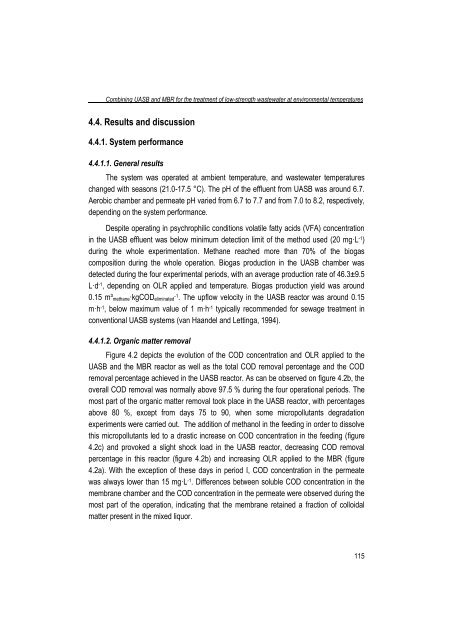Combining submerged membrane technology with anaerobic and ...
Combining submerged membrane technology with anaerobic and ...
Combining submerged membrane technology with anaerobic and ...
You also want an ePaper? Increase the reach of your titles
YUMPU automatically turns print PDFs into web optimized ePapers that Google loves.
<strong>Combining</strong> UASB <strong>and</strong> MBR for the treatment of low-strength wastewater at environmental temperatures4.4. Results <strong>and</strong> discussion4.4.1. System performance4.4.1.1. General resultsThe system was operated at ambient temperature, <strong>and</strong> wastewater temperatureschanged <strong>with</strong> seasons (21.0-17.5 °C). The pH of the effluent from UASB was around 6.7.Aerobic chamber <strong>and</strong> permeate pH varied from 6.7 to 7.7 <strong>and</strong> from 7.0 to 8.2, respectively,depending on the system performance.Despite operating in psychrophilic conditions volatile fatty acids (VFA) concentrationin the UASB effluent was below minimum detection limit of the method used (20 mg·L -1 )during the whole experimentation. Methane reached more than 70% of the biogascomposition during the whole operation. Biogas production in the UASB chamber wasdetected during the four experimental periods, <strong>with</strong> an average production rate of 46.3±9.5L·d -1 , depending on OLR applied <strong>and</strong> temperature. Biogas production yield was around0.15 m³ methane·kgCOD eliminated-1. The upflow velocity in the UASB reactor was around 0.15m·h -1 , below maximum value of 1 m·h -1 typically recommended for sewage treatment inconventional UASB systems (van Ha<strong>and</strong>el <strong>and</strong> Lettinga, 1994).4.4.1.2. Organic matter removalFigure 4.2 depicts the evolution of the COD concentration <strong>and</strong> OLR applied to theUASB <strong>and</strong> the MBR reactor as well as the total COD removal percentage <strong>and</strong> the CODremoval percentage achieved in the UASB reactor. As can be observed on figure 4.2b, theoverall COD removal was normally above 97.5 % during the four operational periods. Themost part of the organic matter removal took place in the UASB reactor, <strong>with</strong> percentagesabove 80 %, except from days 75 to 90, when some micropollutants degradationexperiments were carried out. The addition of methanol in the feeding in order to dissolvethis micropollutants led to a drastic increase on COD concentration in the feeding (figure4.2c) <strong>and</strong> provoked a slight shock load in the UASB reactor, decreasing COD removalpercentage in this reactor (figure 4.2b) <strong>and</strong> increasing OLR applied to the MBR (figure4.2a). With the exception of these days in period I, COD concentration in the permeatewas always lower than 15 mg·L -1 . Differences between soluble COD concentration in the<strong>membrane</strong> chamber <strong>and</strong> the COD concentration in the permeate were observed during themost part of the operation, indicating that the <strong>membrane</strong> retained a fraction of colloidalmatter present in the mixed liquor.115
















